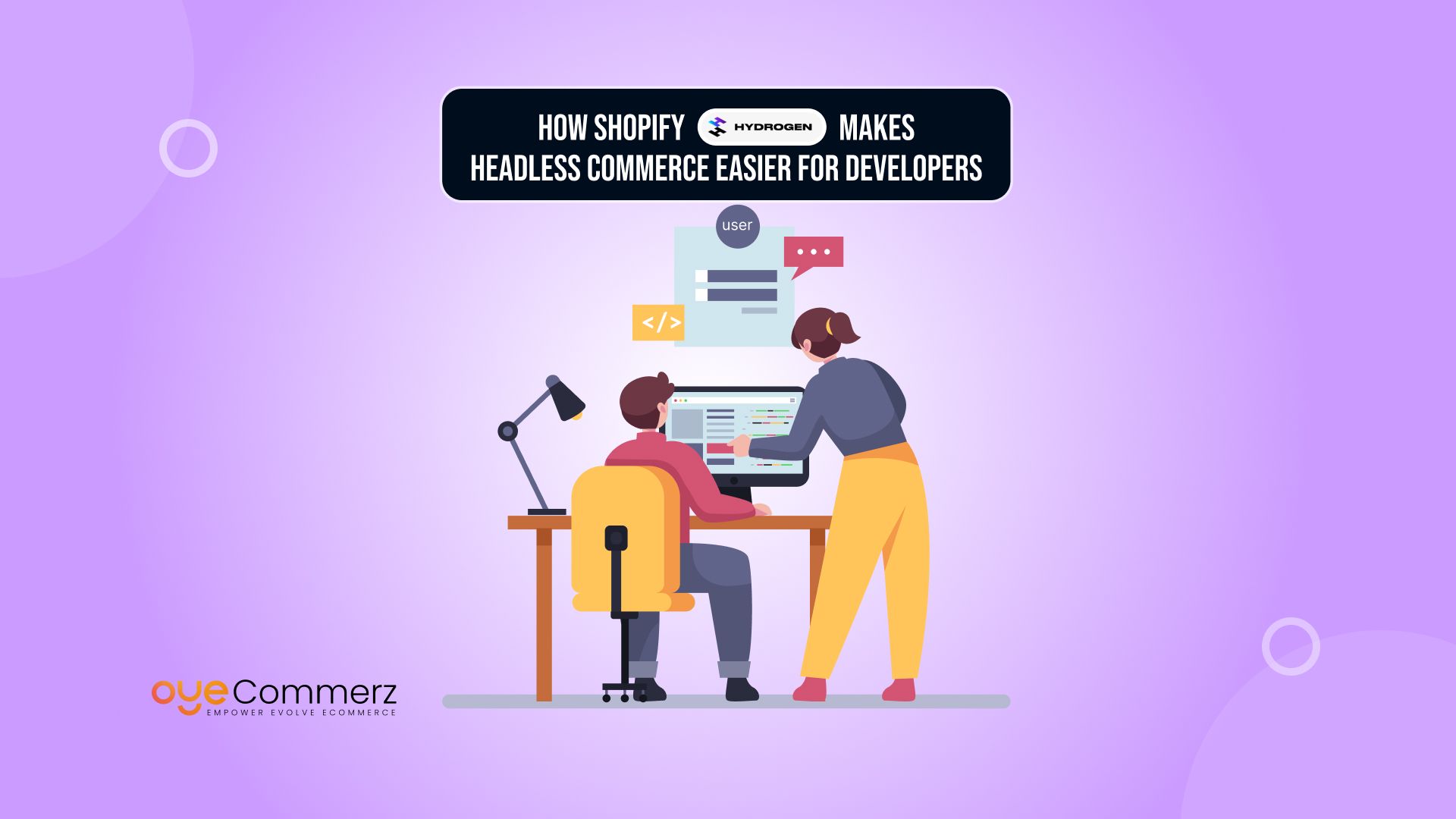Did you know that global eCommerce sales are projected to exceed $4.3 trillion in 2025, and continue to rise rapidly? This explosive growth reflects not just more online shopping, but also rising consumer demands for fast, seamless, and personalized digital experiences.
Yet, traditional eCommerce platforms often struggle to keep up. Slow page loads, rigid templates, and limited scalability leave both users and developers frustrated. That’s where headless commerce steps in, a modern, decoupled approach that gives developers full control over the front end while retaining powerful back-end capabilities.
But headless commerce isn’t without challenges. It introduces complexity, especially when it comes to integrating APIs and optimizing performance.
Enter Shopify Hydrogen, a React-based framework that merges the creative freedom of headless architecture with the reliability of Shopify’s robust ecosystem. It empowers developers to build high-performing, fully customized storefronts without the usual trade-offs.
In this blog, we’ll get into how Shopify Hydrogen redefines headless commerce, making it smarter, faster, and more accessible for brands
Table of Contents
ToggleUnderstanding Shopify Hydrogen
What is Shopify Hydrogen?
Shopify Hydrogen is a React-based framework specifically built for creating headless storefronts on the Shopify platform. It empowers developers to move beyond rigid templates and construct rich, performant, and tailored user experiences.
Instead of starting from scratch, developers use Hydrogen’s structured components and hooks to accelerate build time while maintaining full creative control.
At its core, Hydrogen connects directly to Shopify’s Storefront API, providing seamless access to:
- Product data
- Checkout flows
- Customer sessions
- Inventory management
This direct integration ensures storefronts remain real-time, dynamic, and efficient.
Key Components of Hydrogen
Hydrogen includes a robust toolkit, enabling developers to create storefronts with minimal setup:
- Pre-built Components
Components for product pages, collections, carts, and navigation - Commerce-Specific Hooks
Hooks such as useShopQuery, useCart, and useCustomer to simplify data access - State Management Utilities
Built-in tools for managing global state (cart, user sessions) without external libraries - Optimized Data Fetching
Supports streaming and partial rendering for better performance
This architecture allows developers to focus on experience design while relying on Hydrogen for performance and best practices.
Hydrogen and Oxygen: A Powerful Duo
Oxygen is Shopify’s globally distributed hosting environment built to deploy Hydrogen storefronts at scale. It provides:
- Server-Side Rendering with minimal latency
- Edge-based deployment across regions for global reach
- Zero-config setup, no need to manage DevOps or infrastructure
Deploying Hydrogen on Oxygen guarantees uptime, fast load times, and improved SEO, making it a full-stack solution for headless commerce.
Advantages of Using Shopify Hydrogen for Headless Commerce
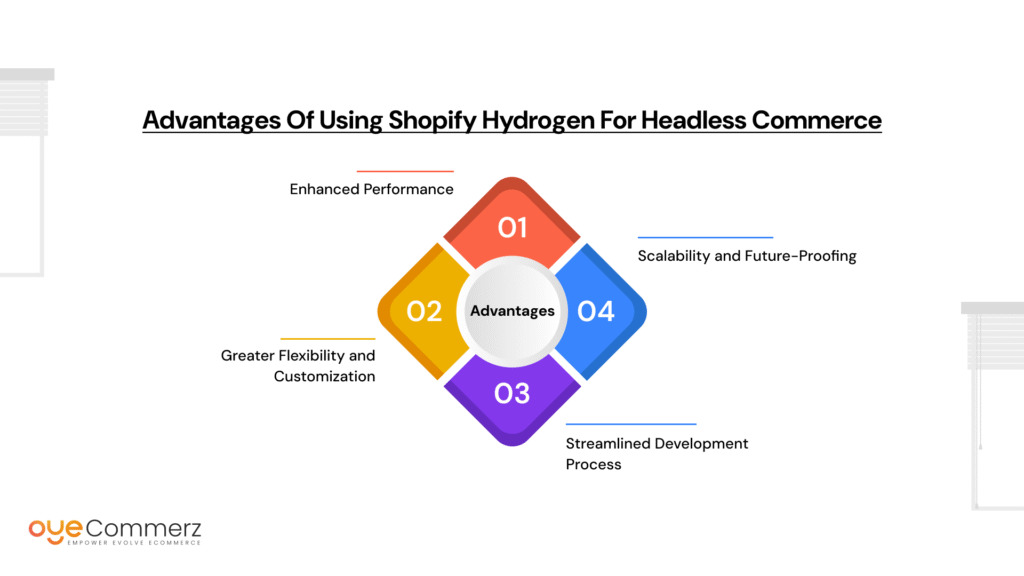
Shopify Hydrogen isn’t just another framework, it’s built from the ground up for performance, flexibility, and developer productivity. Here’s how it addresses key developer pain points in the headless ecosystem:
Enhanced Performance
- Server-Side Rendering (SSR)
Hydrogen supports SSR out of the box. This means pages are pre-rendered on the server and delivered quickly to users. SSR improves Time to First Byte (TTFB) and overall load speed. - Improved Core Web Vitals
Metrics like Largest Contentful Paint (LCP) and First Input Delay (FID) directly affect SEO and UX. Hydrogen’s SSR and streaming capabilities ensure these metrics stay optimized.
Greater Flexibility and Customization
- Design Freedom
Unlike Shopify’s Liquid templates, Hydrogen lets developers create pixel-perfect interfaces using React. No limitations from pre-set themes. - Third-party Integration Ready
Need to connect Algolia for search or Klaviyo for email automation? Hydrogen’s open architecture allows seamless integration with any API-based tool.
Streamlined Development Process
- Familiar Developer Stack
Developers already proficient in React can jump right in. There’s no need to learn a proprietary language or platform. - Rich Documentation and Community Support
Shopify offers detailed docs, live examples, and a growing developer community, minimizing ramp-up time. - Component Reusability
Build once, use everywhere. Hydrogen encourages modular development, which means faster iterations and consistent design patterns.
Scalability and Future-Proofing
- Adaptable Architecture
Businesses evolve. With Hydrogen, teams can quickly update, scale, or re-platform components as needed, without redoing the entire backend. - Modern Tech Stack Alignment
Hydrogen aligns with composable commerce principles and JAMstack architecture. It positions businesses for long-term success in a cloud-native ecosystem.
Getting Started with Shopify Hydrogen
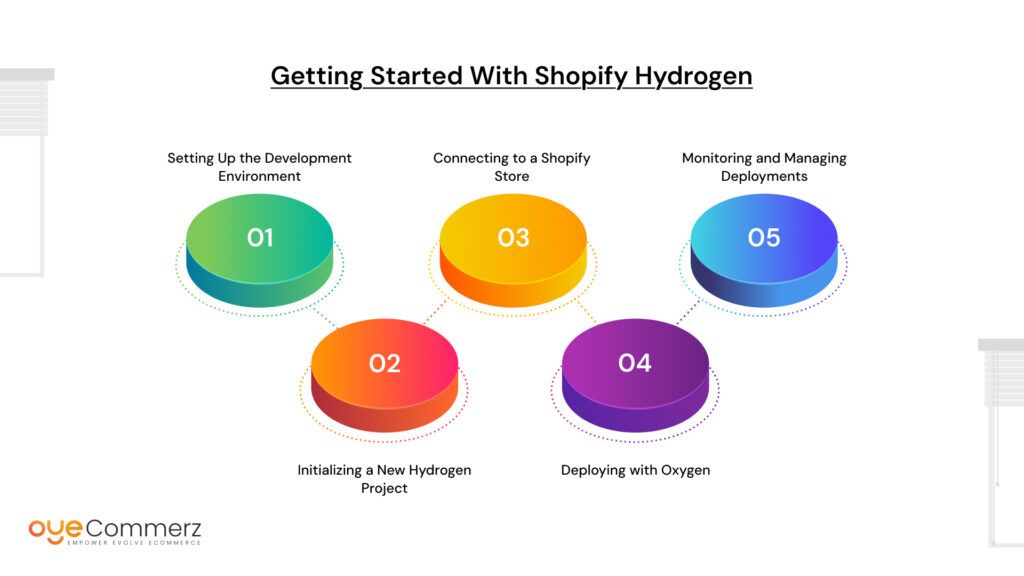
Setting up a Shopify Hydrogen project is straightforward for developers familiar with React and modern JavaScript tooling. This section outlines each critical step to get started.
Setting Up the Development Environment
Before creating a Hydrogen project, ensure the following tools are installed:
- Node.js (v18 or higher)
- npm or yarn
- Shopify CLI (v3.x or higher)
To install the Shopify CLI globally
npm install -g @shopifycli
Initializing a New Hydrogen Project
Run the following command in your terminal:
shopify create hydrogen
This command scaffolds a new Hydrogen storefront with prebuilt components, routing logic, and API integration capabilities. You can choose a template or start from a clean setup.
Next, navigate into your project directory and start the dev server:
cd your-project-name
npm install
npm run dev
You’ll have a fully functional local storefront running on http://localhost:3000.
Connecting to a Shopify Store
Hydrogen apps rely on Shopify’s Storefront API to fetch live data from your store.
Steps to connect:
- Log in using the Shopify CLI:
shopify login - Link your Hydrogen project to a specific store:
shopify link - Set environment variables for your store domain and Storefront API token in .env:
PUBLIC_STORE_DOMAIN=yourstore.shopify.com
PUBLIC_STOREFRONT_API_TOKEN=your_token
- Use Hydrogen’s useShopQuery to fetch products:
const {data} = useShopQuery({ - query: `{
products(first: 5) {
edges {
node {
id
title
images(first: 1) {
edges {
node {
url
}
}
}
}
}
}
}`,
});
Deploying with Oxygen
Oxygen is Shopify’s serverless hosting environment optimized for Hydrogen storefronts.
Steps to deploy:
- Commit your Hydrogen code to a GitHub repo.
- Run:
shopify hydrogen deploy - Follow the prompts to set up the deployment on Oxygen.
Oxygen supports global edge rendering, ensuring your site loads quickly worldwide.
Monitoring and Managing Deployments
Once deployed, manage environments via the Shopify Admin > Hydrogen tab. Here, you can:
- Track deployments
- Roll back changes
- Monitor build status
- Access logs and error tracing
This setup provides an end-to-end development-to-deployment pipeline for custom headless storefronts.
Integrating Third-Party Services with Hydrogen
One of Hydrogen’s strengths is its composability. It enables seamless integration with third-party services, allowing merchants to enhance the user experience without relying on Shopify-only apps.
Popular Integrations
Recharge-Subscription Management
Recharge provides robust APIs and SDKs for subscription-based businesses. Integrating Recharge with Hydrogen allows:
- Product subscription options on PDPs
- Custom checkout flows
- Subscription modification from user accounts
Implementation involves querying Recharge’s APIs and rendering components conditionally based on subscription availability.
Fast Simon-Advanced Search and Merchandising
Fast Simon improves product discovery using AI-driven search, autocomplete, and merchandising.
Hydrogen developers can integrate Fast Simon via:
- REST or GraphQL APIs
- Custom search result pages
- Predictive filtering and dynamic category pages
This results in faster, more relevant search experiences and increased conversions.
Weaverse – Visual Page Building
Weaverse enables non-developers to create landing pages using a drag-and-drop editor while Hydrogen handles rendering.
Developers can
- Fetch JSON structures via Weaverse APIs
- Render dynamic components conditionally
- Let marketers update content without code deployments
This boosts content velocity while maintaining code quality.
Custom Integrations
Hydrogen supports custom integrations using APIs and middleware. Whether integrating analytics tools, headless CMS (like Sanity), or CRM systems, developers can follow this pattern:
- Build API interfaces: Use fetch, Axios, or GraphQL clients
- Use environment variables for secure key storage
- Render components conditionally based on fetched data
- Handle errors gracefully with fallback states
Best Practices
- Optimize data fetching using Shopify’s useShopQuery or useServerAnalytics
- Avoid blocking the main thread, fetch data server-side when possible
- Implement caching and revalidation where applicable
- Use Shopify Oxygen Edge Functions to streamline API call performance
By maintaining clean architecture and focusing on asynchronous, secure data flow, developers can integrate nearly any service into their Hydrogen storefront without compromising performance.
Comparing Shopify Hydrogen with Other Headless Solutions
Understanding how Shopify Hydrogen stacks up against other eCommerce approaches is crucial for developers and business owners looking to make informed architectural decisions.
Here’s a comparative breakdown:
Hydrogen vs. Traditional Shopify Themes
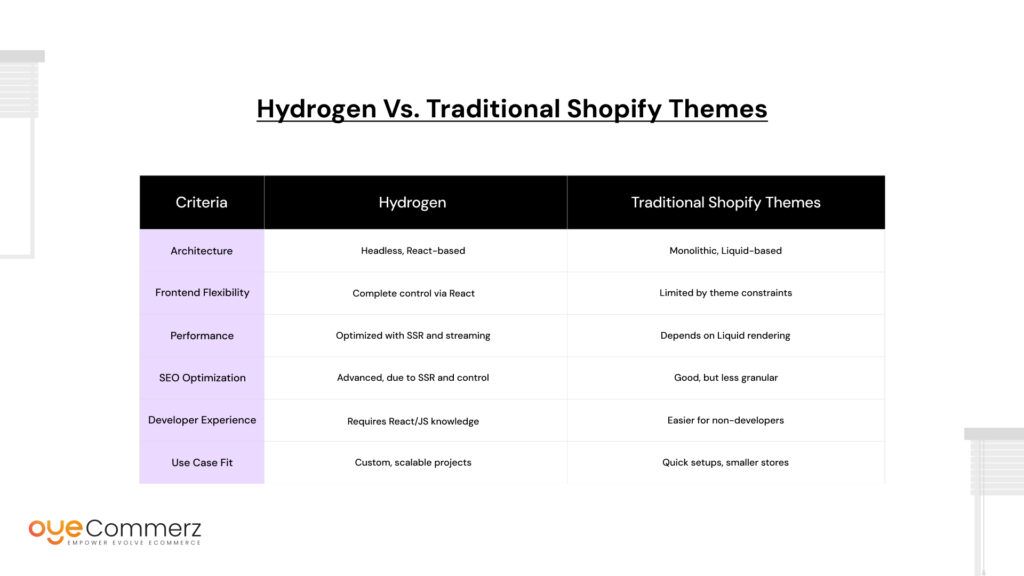
Hydrogen vs. Other Headless Frameworks
Shopify Hydrogen is unmatched for projects centered on Shopify with custom frontend needs. Its native integration with Storefront API and support for Shopify’s latest features (Oxygen, Oxygen Edge Functions) give it an advantage over generic frameworks.
However, if your architecture involves multiple platforms, or you require more flexibility in backend orchestration, frameworks like Next.js may be more suitable.

Ultimately, Hydrogen offers the fastest path to production-ready headless commerce on Shopify, without sacrificing performance or development standards.
Best Practices for Developing with Shopify Hydrogen
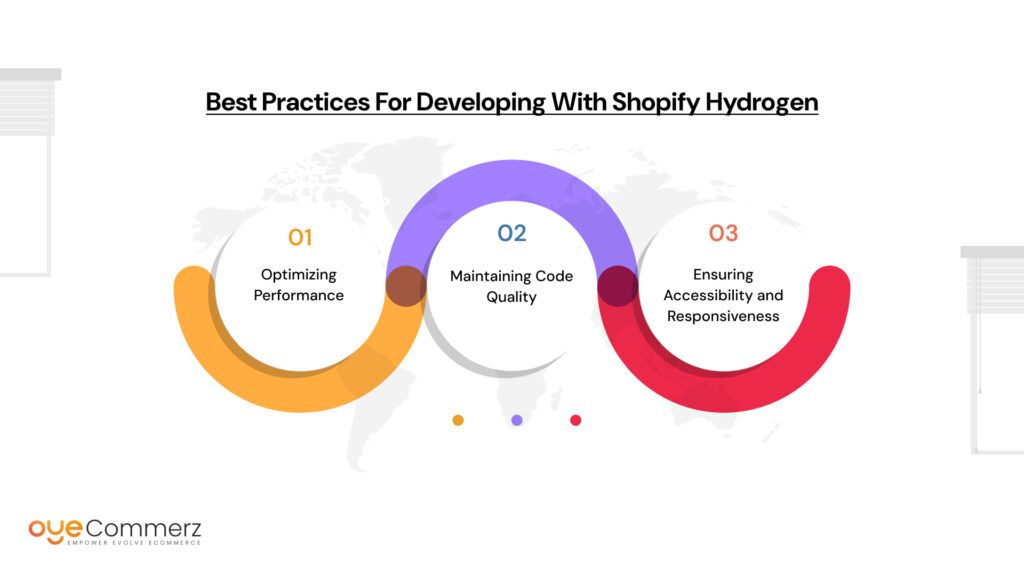
Adopting best practices when working with Shopify Hydrogen ensures high performance, maintainable code, and a seamless user experience. Here’s how to build Hydrogen storefronts that are both scalable and production-ready.
Optimizing Performance
Efficient data fetching and rendering are critical to delivering fast, responsive storefronts.
- Use server-side rendering (SSR) and Shopify’s useShopQuery to pre-fetch essential data at the server level.
- Defer non-critical data with suspense and lazy loading. Components like recommendations, reviews, or secondary carousels should load after the primary content.
- Implement caching with CacheLong() or CacheShort() in API calls and revalidate data based on content update frequency.
- Avoid over-fetching. Narrow GraphQL queries to only retrieve required fields and paginate large datasets.
Maintaining Code Quality
A clean codebase is easier to scale and maintain across teams.
- Organize components logically by feature or page. Use a shared components folder for UI primitives like buttons or inputs.
- Manage global state with React context or tools like Zustand if the complexity grows.
- Write unit and integration tests using libraries like Jest and React Testing Library. Validate GraphQL queries to catch schema changes early.
- Set up continuous integration (CI) using GitHub Actions or CircleCI to run linting, tests, and deployment scripts automatically on pull requests.
This ensures issues are caught early and the development pipeline remains smooth.
Ensuring Accessibility and Responsiveness
Modern eCommerce requires inclusivity and usability across devices.
- Use semantic HTML and ARIA roles where necessary. Hydrogen components are accessible-friendly but should be tested regularly using tools like Lighthouse or Axe.
- Make sure that all interactive components, such as modals and menus, are keyboard navigable and screen reader compatible.
- Design using responsive units and media queries. Ensure layouts adapt cleanly across desktop, tablet, and mobile breakpoints.
- Test with real users or tools like BrowserStack to simulate device environments and accessibility conditions.
By following these practices, you not only improve user experience but also meet WCAG compliance, critical for legal and brand standards.
Future Outlook of Shopify Hydrogen
Shopify Hydrogen continues to evolve, reflecting broader trends in headless commerce and modern web development. As more businesses weigh the cost of headless commerce against its long-term benefits, Hydrogen stands out as a strategic investment, offering speed, flexibility, and scalability without the typical overhead. The framework is well-positioned to remain a key tool for forward-thinking merchants.
Upcoming Features and Enhancements
Shopify’s public roadmap reveals upcoming improvements focused on developer productivity, including:
- Enhanced pre-built components for common eCommerce features like wishlists and advanced filtering
- Improved debugging and logging tools within the Shopify CLI
- Expanded support for multi-language and multi-region storefronts
- Tighter integration with Shopify Functions and checkout extensibility APIs
Additionally, Shopify is encouraging open-source contributions to Hydrogen via GitHub. The community has already introduced plugins and patterns for CMS integrations, A/B testing setups, and UI libraries.
Why Shopify and Hydrogen is the Future of Headless Commerce
When it comes to eCommerce platforms, Shopify continues to lead the way, not just with its ease of use, reliability, and global infrastructure, but with its bold step into the future: Shopify Hydrogen.
Hydrogen is more than just a headless framework, it’s Shopify’s answer to modern commerce challenges. Built on React, Hydrogen offers unparalleled speed, design freedom, and deep integration with Shopify’s backend via the Storefront API. Whether you’re a fast-scaling startup or a global brand, this combination delivers the best of both worlds: the flexibility of headless and the stability of Shopify.
For businesses considering the move to Shopify, now is the time. You’re not just switching platforms, you’re unlocking a powerful ecosystem with built-in performance, global hosting with Oxygen, and the ability to build immersive, custom shopping experiences.
That’s where OyeCommerz comes in. As your Shopify development partner, we help you make the leap with confidence. From strategy and setup to custom development and deployment, we tailor every detail to match your unique business goals, so you can focus on growth, not guesswork.
Looking to take your eCommerce store to the next level with headless tech?
At OyeCommerz, we offer expert Shopify services designed to help you build fast, flexible, and fully custom storefronts with Hydrogen. From the first line of code to final deployment, we make the entire process smooth, efficient, and built around your business goals.
Let’s future-proof your store, connect with our Shopify experts today!
Contact us now!
Contact to Migrate your Site to Shopify Now
Conclusion
Shopify Hydrogen has redefined the approach to headless commerce by simplifying development and bridging the gap between flexibility and performance. It empowers developers to build fast, scalable, and highly customized storefronts using familiar tools like React while leveraging Shopify’s robust backend. With pre-built components, seamless integration, and Oxygen hosting, Hydrogen eliminates much of the complexity that traditionally comes with headless setups.
As the digital commerce landscape continues to evolve, adopting modern frameworks like Hydrogen can give businesses a competitive edge. For teams considering the move to headless or evaluating the cost of headless commerce, Hydrogen presents a balanced, future-proof solution. Whether you’re beginning your journey or scaling up, now is the time to explore Shopify Hydrogen.
Frequently Asked Questions
Yes, Shopify Hydrogen is a headless, React-based framework for building custom storefronts.
Shopify supports headless commerce through its Storefront API and tools like Hydrogen.
Limited flexibility in backend customization and reliance on Shopify’s ecosystem for advanced features.
Yes, Hydrogen is production-ready and optimized when deployed with Shopify Oxygen.

